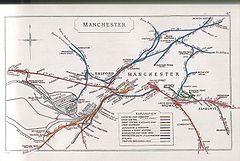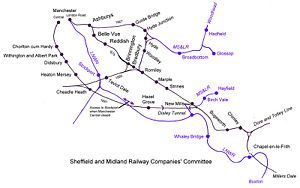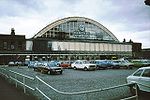
Manchester Central railway station
Encyclopedia
Manchester Central railway station is a former railway station in Manchester City Centre
, England
. One of Manchester
's main railway terminals between 1880 and 1969, it now houses an exhibition and conference centre named Manchester Central.
(CLC), and was officially opened on 1 July 1880. The architect was Sir John Fowler and the engineers were Richard Johnson, Andrew Johnston and Charles Sacré
for the three companies which formed the CLC.
While the main station was being built a temporary facility called Manchester Free Trade Hall Station (after a landmark building
nearby) was in use from 9 September 1877. This consisted of two wooden platforms serving four tracks. When Central opened the temporary station was converted to become Manchester Central Goods.
On 6 October 1965, the final victim of the Moors Murders
, 17-year-old apprentice engineer Edward Evans was met at the station by Ian Brady before he was brutally killed with an axe.
truss
structure 550 feet (168 m) long with a span of 210 feet (64 m), and was 90 feet (27 m) high at its apex above the railtracks. Glass covered the middle section, timber (inside) and slate (outside) covered the outer quarters. The end screens were glazed with timber boarding surrounding the outer edges. It was constructed by Andrew Handyside and Co.
The substructure and masonry partition were provided by Robert Neill and Sons of Manchester. Underneath the train shed there is a large brick undercroft
with intersecting tunnel vaults. This was used for storage and was connected to the adjacent goods sidings by a carriage lift.
A wooden building was erected at the front of the station, housing ticket offices and waiting rooms. This was planned to be a temporary structure, to be replaced by a grander edifice, for example a hotel and railway offices as at London St Pancras, but it remained in use until the station closed. The Midland Hotel
was built by the Midland Railway
in 1898-1903 on an adjacent site.

 The Midland Railway
The Midland Railway
(MR), one of the CLC's partners, used Manchester Central as its terminus for services including express trains to London St Pancras. Beginning in 1938, the London Midland and Scottish Railway (successor to the MR) ran two prestige expresses, The Peaks and the Palatine
, stopping en route
at Chinley
, Millers Dale
, Matlock
, Derby and Leicester
.
Between 1960 and 15 April 1966, during the electrification
of the West Coast Main Line
, Central Station was the terminus for the Midland Pullman
, a streamlined blue six-coach diesel multiple unit. This stopped at Cheadle Heath
(now closed), before running fast to St Pancras.
Services through Millers Dale finished in July 1968 when the line was closed as a through route. The station provided local services to Chester and Liverpool but closed to passengers on 5 May 1969, when the remaining services were switched to Manchester Oxford Road and Manchester Piccadilly stations.

For over a decade, Central Station fell into a dilapidated state (including suffering a fire,) and was used as a car park
. The property was acquired by Greater Manchester Council
and in 1982 work began on converting the building into an exhibition centre, which opened in 1986 as the Greater Manchester Exhibition and Conference Centre ("G-Mex") (later renamed Manchester Central in honour of its railway history). The undercroft was converted into a car park, serving the centre and Bridgewater Hall
.
 The opening in 1992 of the Metrolink
The opening in 1992 of the Metrolink
light rail
system has seen the conversion of suburban heavy rail lines such as the former Manchester, South Junction and Altrincham Railway
to Altrincham, and there are further proposals to re-open the disused Cheshire Lines Committee
route via Didsbury
. With the introduction of Metrolink, rail services from south Manchester run once more to Central Station. However, instead of trains running into the Central Station arch, light rail vehicles now cross the railway viaduct and stop at Deansgate-Castlefield Metrolink station (formerly G-Mex). They then run down a ramp which runs parallel to Lower Mosley Street, alongside the south-eastern side of the former train shed, before reaching street level where they operate as trams and head towards St Peter's Square.
Manchester City Centre
Manchester city centre is the central business district of Manchester, England. It lies within the Manchester Inner Ring Road, next to the River Irwell...
, England
England
England is a country that is part of the United Kingdom. It shares land borders with Scotland to the north and Wales to the west; the Irish Sea is to the north west, the Celtic Sea to the south west, with the North Sea to the east and the English Channel to the south separating it from continental...
. One of Manchester
Manchester
Manchester is a city and metropolitan borough in Greater Manchester, England. According to the Office for National Statistics, the 2010 mid-year population estimate for Manchester was 498,800. Manchester lies within one of the UK's largest metropolitan areas, the metropolitan county of Greater...
's main railway terminals between 1880 and 1969, it now houses an exhibition and conference centre named Manchester Central.
History
The station was built between 1875 and 1880 by the Cheshire Lines CommitteeCheshire Lines Committee
The Cheshire Lines Committee was the second largest joint railway in Great Britain, with 143 route miles. Despite its name, approximately 55% of its system was in Lancashire. In its publicity material it was often styled as the Cheshire Lines Railway...
(CLC), and was officially opened on 1 July 1880. The architect was Sir John Fowler and the engineers were Richard Johnson, Andrew Johnston and Charles Sacré
Charles Sacre
Charles Reboul Sacré was an English engineer, Engineer and Superintendent of the Locomotive and Stores Department of the Manchester, Sheffield and Lincolnshire Railway. Samuel Waite Johnson was his assistant between 1859 and 1864...
for the three companies which formed the CLC.
While the main station was being built a temporary facility called Manchester Free Trade Hall Station (after a landmark building
Free Trade Hall
The Free Trade Hall, Peter Street, Manchester, was a public hall constructed in 1853–6 on St Peter's Fields, the site of the Peterloo Massacre and is now a hotel. The hall was built to commemorate the repeal of the Corn Laws in 1846. The architect was Edward Walters The hall subsequently was...
nearby) was in use from 9 September 1877. This consisted of two wooden platforms serving four tracks. When Central opened the temporary station was converted to become Manchester Central Goods.
On 6 October 1965, the final victim of the Moors Murders
Moors murders
The Moors murders were carried out by Ian Brady and Myra Hindley between July 1963 and October 1965, in and around what is now Greater Manchester, England. The victims were five children aged between 10 and 17—Pauline Reade, John Kilbride, Keith Bennett, Lesley Ann Downey and Edward Evans—at least...
, 17-year-old apprentice engineer Edward Evans was met at the station by Ian Brady before he was brutally killed with an axe.
Construction details
The station's roof is a single span wrought ironWrought iron
thumb|The [[Eiffel tower]] is constructed from [[puddle iron]], a form of wrought ironWrought iron is an iron alloy with a very low carbon...
truss
Truss
In architecture and structural engineering, a truss is a structure comprising one or more triangular units constructed with straight members whose ends are connected at joints referred to as nodes. External forces and reactions to those forces are considered to act only at the nodes and result in...
structure 550 feet (168 m) long with a span of 210 feet (64 m), and was 90 feet (27 m) high at its apex above the railtracks. Glass covered the middle section, timber (inside) and slate (outside) covered the outer quarters. The end screens were glazed with timber boarding surrounding the outer edges. It was constructed by Andrew Handyside and Co.
Andrew Handyside
Andrew Handyside and Company was an iron founder in Derby, England in the nineteenth century.-Biography:Born in Edinburgh, Scotland in 1805, Handyside worked in his uncle Charles Baird's engineering business in St. Petersburg before taking over the Brittania Foundry in 1848...
The substructure and masonry partition were provided by Robert Neill and Sons of Manchester. Underneath the train shed there is a large brick undercroft
Undercroft
An undercroft is traditionally a cellar or storage room, often brick-lined and vaulted, and used for storage in buildings since medieval times. In modern usage, an undercroft is generally a ground area which is relatively open to the sides, but covered by the building above.- History :While some...
with intersecting tunnel vaults. This was used for storage and was connected to the adjacent goods sidings by a carriage lift.
A wooden building was erected at the front of the station, housing ticket offices and waiting rooms. This was planned to be a temporary structure, to be replaced by a grander edifice, for example a hotel and railway offices as at London St Pancras, but it remained in use until the station closed. The Midland Hotel
Midland Hotel (Manchester)
The Midland is a 312 bedroom grand hotel situated in Manchester city centre, in North West England. Opened in September 1903, it was built by the Midland Railway to serve the adjacent Manchester Central railway station...
was built by the Midland Railway
Midland Railway
The Midland Railway was a railway company in the United Kingdom from 1844 to 1922, when it became part of the London, Midland and Scottish Railway....
in 1898-1903 on an adjacent site.
Railway usage


Midland Railway
The Midland Railway was a railway company in the United Kingdom from 1844 to 1922, when it became part of the London, Midland and Scottish Railway....
(MR), one of the CLC's partners, used Manchester Central as its terminus for services including express trains to London St Pancras. Beginning in 1938, the London Midland and Scottish Railway (successor to the MR) ran two prestige expresses, The Peaks and the Palatine
The Palatine
The Palatine was the name given to an express passenger train, introduced by the London, Midland and Scottish Railway in 1938: the 10.00 from Manchester Central to London St Pancras and the return working, the 16.30 from St Pancras to Manchester Central....
, stopping en route
at Chinley
Chinley railway station
Chinley railway station serves the village of Chinley in Derbyshire. The station is 28 km south east of Manchester Piccadilly....
, Millers Dale
Millers Dale railway station
Millers Dale railway station was a station situated in Millers Dale in the Peak District. It was built in 1863 by the Midland Railway on its extension of the Manchester, Buxton, Matlock and Midlands Junction Railway from Rowsley....
, Matlock
Matlock railway station
Matlock Railway Station is a railway station owned by Network Rail and managed by East Midlands Trains. It is located in the Derbyshire town of Matlock in Derbyshire, England. The station is now currently the terminus of both the Derwent Valley Line from Derby and Peak Rail who operate heritage...
, Derby and Leicester
Leicester railway station
Leicester railway station serves the City of Leicester in Leicestershire, England.As of late 2009 Leicester is a Penalty fare station, a valid ticket or Permit to travel must be shown when requested.-Background:...
.
Between 1960 and 15 April 1966, during the electrification
Railway electrification in Great Britain
Railway electrification in Great Britain started towards of the 19th century. A great range of voltages have been used in the intervening period using both overhead lines and third rails, however the most common standard for mainline services is now 25 kV AC using overhead lines and the...
of the West Coast Main Line
West Coast Main Line
The West Coast Main Line is the busiest mixed-traffic railway route in Britain, being the country's most important rail backbone in terms of population served. Fast, long-distance inter-city passenger services are provided between London, the West Midlands, the North West, North Wales and the...
, Central Station was the terminus for the Midland Pullman
Midland Pullman
The Midland Pullman was the name given to a former express passenger train service operating on British Railways' old Midland Main Line between and via and Millers Dale...
, a streamlined blue six-coach diesel multiple unit. This stopped at Cheadle Heath
Cheadle Heath railway station
Cheadle Heath railway station was a railway station, which between 1901 and 1968 served Cheadle and Cheadle Hulme, now districts of Stockport, United Kingdom.-Construction and opening:...
(now closed), before running fast to St Pancras.
Services through Millers Dale finished in July 1968 when the line was closed as a through route. The station provided local services to Chester and Liverpool but closed to passengers on 5 May 1969, when the remaining services were switched to Manchester Oxford Road and Manchester Piccadilly stations.
Dereliction and redevelopment

For over a decade, Central Station fell into a dilapidated state (including suffering a fire,) and was used as a car park
Parking lot
A parking lot , also known as car lot, is a cleared area that is intended for parking vehicles. Usually, the term refers to a dedicated area that has been provided with a durable or semi-durable surface....
. The property was acquired by Greater Manchester Council
Greater Manchester County Council
The Greater Manchester County Council — also known as the Greater Manchester Council — was the top-tier local government administrative body for Greater Manchester from 1974 to 1986...
and in 1982 work began on converting the building into an exhibition centre, which opened in 1986 as the Greater Manchester Exhibition and Conference Centre ("G-Mex") (later renamed Manchester Central in honour of its railway history). The undercroft was converted into a car park, serving the centre and Bridgewater Hall
Bridgewater Hall
The Bridgewater Hall is an international concert venue in Manchester city centre, England. It cost around £42 million to build and currently hosts over 250 performances a year....
.
Light rail

Manchester Metrolink
Metrolink is a light rail system in Greater Manchester, England. It consists of four lines which converge in Manchester city centre and terminate in Bury, Altrincham, Eccles and Chorlton-cum-Hardy. The system is owned by Transport for Greater Manchester and operated under contract by RATP Group...
light rail
Light rail
Light rail or light rail transit is a form of urban rail public transportation that generally has a lower capacity and lower speed than heavy rail and metro systems, but higher capacity and higher speed than traditional street-running tram systems...
system has seen the conversion of suburban heavy rail lines such as the former Manchester, South Junction and Altrincham Railway
Manchester, South Junction and Altrincham Railway
The Manchester South Junction and Altrincham Railway was a suburban railway which operated a 13.7 km route between Altrincham in Cheshire and London Road Station in Manchester....
to Altrincham, and there are further proposals to re-open the disused Cheshire Lines Committee
Cheshire Lines Committee
The Cheshire Lines Committee was the second largest joint railway in Great Britain, with 143 route miles. Despite its name, approximately 55% of its system was in Lancashire. In its publicity material it was often styled as the Cheshire Lines Railway...
route via Didsbury
Didsbury railway station
Didsbury railway station is a former station in Didsbury, in the southern suburbs of Manchester, England, United Kingdom. The station was located on Wilmslow Road, just north of the junction with Barlow Moor Road and opposite Didsbury Library...
. With the introduction of Metrolink, rail services from south Manchester run once more to Central Station. However, instead of trains running into the Central Station arch, light rail vehicles now cross the railway viaduct and stop at Deansgate-Castlefield Metrolink station (formerly G-Mex). They then run down a ramp which runs parallel to Lower Mosley Street, alongside the south-eastern side of the former train shed, before reaching street level where they operate as trams and head towards St Peter's Square.
See also
- The Great Northern WarehouseThe Great Northern WarehouseThe Great Northern Warehouse is a former railway goods warehouse building of the Great Northern Railway, which has been redeveloped as a car park and leisure complex. The building is located at the junction of Deansgate and Peter Street in Manchester city centre, England...
A former railway building nearby, now a leisure/shopping complex - Grade II* listed buildings in Greater Manchester

